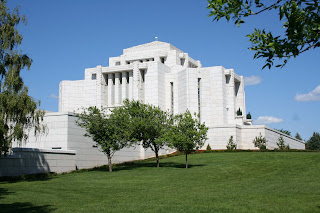At one time the lighthouse was set at the top of the point. However it was not long before it was discovered that the light shining from this small white building could not be seen at sea below the marine layer*. Another lighthouse was built close to the water's edge that successfully warned seafarers of the land ahead.


The Point is now under the care of the National Park Service even though it appears to be part of a military compound. From the visitors' center we could see the harbor of San Diego and the beach in front of the famous Hotel del Coronado. As we were watching, we saw a submarine leave the harbor on its way out to sea. We watched it until it disappeared beyond our view. Shortly after that, another US Navy ship sailed out to the Pacific. It was not until later that we discovered that the ship was the USS Bonhomme Richard.
From above the ship looked a lot like an aircraft carrier. It has a flight deck but it also has the capability of carrying smaller assault vessels.
That evening as we were trying to find out which ship in the San Diego fleet carried the number 6 on the tower, Earl discovered that it is the fifth carnation of a ship that he toured as a teenager in San Francisco.
The original ship was a gift from King Louis XVI of France to the struggling new nation of the United States. It was named in honor of Benjamin Franklin who was the author of Poor Richard's Almanac. He served as the ambassador to France and published a French version of his almanac. Under John Paul Jones' command, the Bonhomme Richard lived a short but glorious life sinking off the west coast of British Isles the same year as it was bequeathed. The famous quote, "I have not yet begun to fight," is from its final battle.
Five ships have been named the Bonhomme Richard. The one that Earl saw as a teenager would have been the "USS Bon Homme Richard (CV-31), an Essex-class aircraft carrier that saw action at the end of World War II, throughout the Korean War, and through the Vietnam War."
We had no idea when we set out for our adventure that morning that we would encounter a reminder of Earl's own personal history.



*The story of California's coastal fog begins with the chilly Pacific Ocean. Even in summer Southern California ocean temperatures stay in the 60s, which is much cooler than summer temperatures along the U.S. Atlantic Coast.
But, if you sail a couple of hundred miles west or southwest over the Pacific you'll find the water growing warmer and warmer. When warm, humid winds from over this warmer water blow across the cold water closer to the shore, the air cools enough to cause its humidity to condense into fog.
This is sometimes referred to as the "marine layer," but the marine layer is the air that the fog's in, not the fog itself. Thus you hear people talking about "marine layer fog" or "marine layer clouds."
But, if you sail a couple of hundred miles west or southwest over the Pacific you'll find the water growing warmer and warmer. When warm, humid winds from over this warmer water blow across the cold water closer to the shore, the air cools enough to cause its humidity to condense into fog.
This is sometimes referred to as the "marine layer," but the marine layer is the air that the fog's in, not the fog itself. Thus you hear people talking about "marine layer fog" or "marine layer clouds."











































